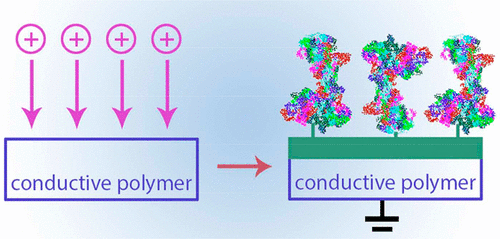当前位置:
X-MOL 学术
›
ACS Biomater. Sci. Eng.
›
论文详情
Our official English website, www.x-mol.net, welcomes your feedback! (Note: you will need to create a separate account there.)
Structural Analysis and Protein Functionalization of Electroconductive Polypyrrole Films Modified by Plasma Immersion Ion Implantation
ACS Biomaterials Science & Engineering ( IF 5.8 ) Pub Date : 2017-08-30 00:00:00 , DOI: 10.1021/acsbiomaterials.7b00369 Alexey Kondyurin 1 , Kostadinos Tsoutas 1 , Quentin-Xavier Latour 1 , Michael J. Higgins 2 , Simon E. Moulton 2 , David R. McKenzie 1 , Marcela M. M. Bilek 1
ACS Biomaterials Science & Engineering ( IF 5.8 ) Pub Date : 2017-08-30 00:00:00 , DOI: 10.1021/acsbiomaterials.7b00369 Alexey Kondyurin 1 , Kostadinos Tsoutas 1 , Quentin-Xavier Latour 1 , Michael J. Higgins 2 , Simon E. Moulton 2 , David R. McKenzie 1 , Marcela M. M. Bilek 1
Affiliation

|
Conducting polymers are good candidates for electronic biomedical devices such as biosensors, artificial nerves, and electrodes for brain tissue. Functionalizing the conducting polymer surface with bioactive molecules can limit adverse immune reactions to the foreign body and direct tissue integration. In this work, we demonstrate a simple one-step method to attach biomolecules covalently to a conductive polymer. Electrochemically synthesized polypyrrole was activated using plasma immersion ion implantation (PIII) in nitrogen. A short treatment with relatively low ion fluence (20 s) was found to enable direct covalent immobilization of protein upon incubation in a protein solution, while the protein is easily removed from untreated polypyrrole by washing in buffer. The covalent nature of the protein immobilization was demonstrated by its resistance to elution when repeatedly washed with SDS detergent. Changes in the surface properties and their evolution with time after PIII activation were studied by a combination of attenuated total reflection Fourier transform infrared spectroscopy (ATR-FTIR), Raman spectroscopy, X-ray photoelectron spectroscopy (XPS), atomic force microscopy (AFM), cyclic voltammetry, and water contact angle measurements. Notable changes in the chemistry of the modified layer in polypyrrole include the appearance of nitrile groups that gradually disappear with time and oxidation of the surface that increases over time in air. The kinetics of surface energy are consistent with the generation of radicals in the modified layer that are lost predominantly through oxidation. The conductivity of the modified surface layer (64 nm in thickness) decreases for low fluence treatments and is partially restored after high fluence treatment. This simple surface modification process opens up the possibility of creating biologically active interfaces for electro-stimulating biomedical devices and electrical sensing of neurological processes.
中文翻译:

等离子体浸没离子注入修饰的导电聚吡咯膜的结构分析和蛋白质功能化
导电聚合物是电子生物医学设备(如生物传感器,人造神经和脑组织电极)的良好候选材料。用生物活性分子对导电聚合物表面进行功能化可以限制对异物的不利免疫反应,并直接组织整合。在这项工作中,我们演示了一种简单的一步法将生物分子共价连接到导电聚合物上。使用氮中的等离子浸入离子注入(PIII)激活电化学合成的聚吡咯。发现用相对较低的离子通量(20 s)进行的短时处理能够在蛋白质溶液中孵育后直接将蛋白质共价固定,而通过在缓冲液中洗涤,很容易从未处理的聚吡咯中除去蛋白质。当用SDS去污剂反复洗涤时,其对洗脱的抗性证明了蛋白质固定化的共价性质。通过衰减全反射傅里叶变换红外光谱(ATR-FTIR),拉曼光谱,X射线光电子能谱(XPS),原子力显微镜(AFM)的组合研究了PIII活化后表面性质的变化及其随时间的演变。 ,循环伏安法和水接触角测量。聚吡咯中改性层化学性质的显着变化包括腈基的出现随时间逐渐消失和表面氧化在空气中随时间增加。表面能的动力学与改性层中自由基的产生一致,该自由基主要通过氧化而损失。对于低通量处理,改性表面层(厚度为64 nm)的电导率会降低,而在高通量处理后会部分恢复。这种简单的表面修饰过程为创建生物活性界面提供了可能,该界面可用于电刺激生物医学设备和神经过程的电感应。
更新日期:2017-08-31
中文翻译:

等离子体浸没离子注入修饰的导电聚吡咯膜的结构分析和蛋白质功能化
导电聚合物是电子生物医学设备(如生物传感器,人造神经和脑组织电极)的良好候选材料。用生物活性分子对导电聚合物表面进行功能化可以限制对异物的不利免疫反应,并直接组织整合。在这项工作中,我们演示了一种简单的一步法将生物分子共价连接到导电聚合物上。使用氮中的等离子浸入离子注入(PIII)激活电化学合成的聚吡咯。发现用相对较低的离子通量(20 s)进行的短时处理能够在蛋白质溶液中孵育后直接将蛋白质共价固定,而通过在缓冲液中洗涤,很容易从未处理的聚吡咯中除去蛋白质。当用SDS去污剂反复洗涤时,其对洗脱的抗性证明了蛋白质固定化的共价性质。通过衰减全反射傅里叶变换红外光谱(ATR-FTIR),拉曼光谱,X射线光电子能谱(XPS),原子力显微镜(AFM)的组合研究了PIII活化后表面性质的变化及其随时间的演变。 ,循环伏安法和水接触角测量。聚吡咯中改性层化学性质的显着变化包括腈基的出现随时间逐渐消失和表面氧化在空气中随时间增加。表面能的动力学与改性层中自由基的产生一致,该自由基主要通过氧化而损失。对于低通量处理,改性表面层(厚度为64 nm)的电导率会降低,而在高通量处理后会部分恢复。这种简单的表面修饰过程为创建生物活性界面提供了可能,该界面可用于电刺激生物医学设备和神经过程的电感应。



























 京公网安备 11010802027423号
京公网安备 11010802027423号